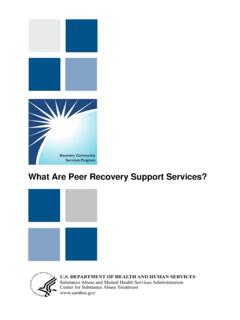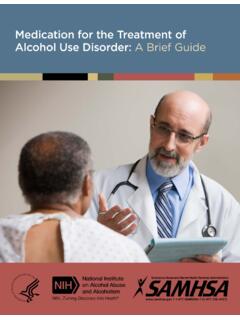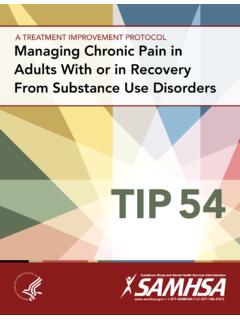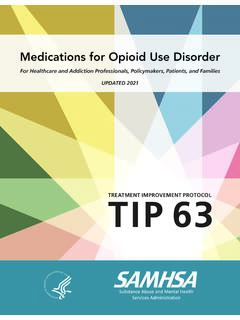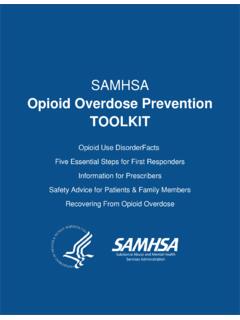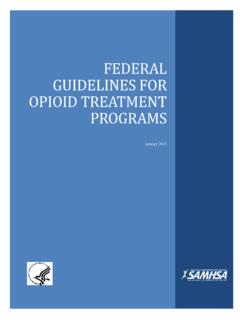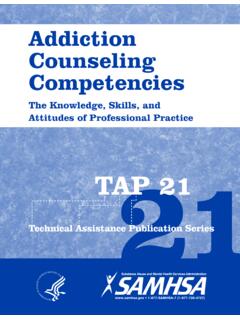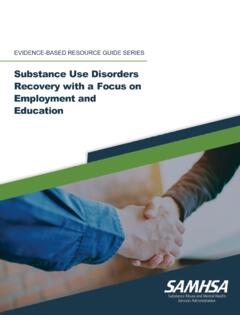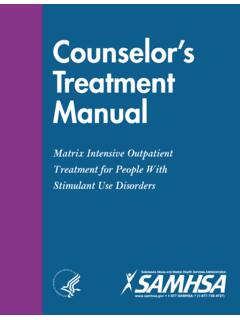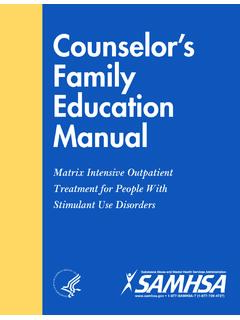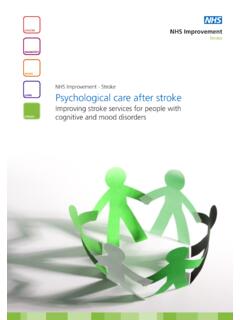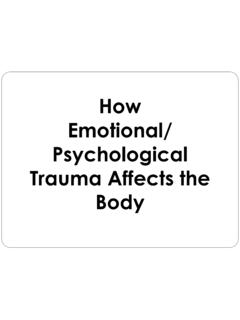Transcription of Brief Intervention and Brief Therapies for Substance Abuse
1 SubstanceAbuseandMentalHealthServicesAdm inistration Center for Su stance A use Treatment BriefInterventions nd BriefTher piesfor Subst nceAbuse Treatment Improvement Protocol (TIP) Series 34 Brief Interventions and Brief Therapies For Substance Abuse Treatment Improvement Protocol (TIP) Series 34 DEPARTMENT OF health AND HUMAN services Substance Abuse and mental health services administration 1 Choke Cherry Road Rockville, MD 20857 Acknowledgments This publication was prepared under contract number 270-95-0013 for the Substance Abuse and mental health services administration (SAMHSA), Department of health and Human services (HHS). Sandra Clunies, , , served as the Contracting Officer The opinions expressed herein are the views of the consensus panel members and do not necessarily reflect the official position of SAMHSA or HHS.
2 No official support of or endorsement by SAMHSA or HHS for these opinions or for the instruments or resources described are intended or should be inferred. The guidelines presented should not be considered substitutes for individualized client care and treatment decisions. Public Domain Notice All materials appearing in this volume except those taken directly from copyrighted sources are in the public domain and may be reproduced or copied without permission from SAMHSA or the authors. Citation of the source is appreciated. However, this publication may not be reproduced or distributed for a fee without the specific, written authorization of the Office of Communications, SAMHSA, HHS. Electronic Access and Printed Copies This publication may be ordered for free from SAMHSA s Publications Ordering Web page at Or, please call SAMHSA at 1-877-SAMHSA-7 (1-877-726-4727) (English and Espa ol).
3 The document can be downloaded from the KAP Web site at Recommended Citation Center for Substance Abuse Treatment. Brief Interventions and Brief Therapies for Substance Abuse . Treatment Improvement Protocol (TIP) Series, No. 34. HHS Publication No. (SMA) 12-3952. Rockville, MD: Substance Abuse and mental health services administration , 1999. Originating Office Quality Improvement and Workforce Development Branch, Division of services Improvement, Center for Substance Abuse Treatment, Substance Abuse and mental health services administration , 1 Choke Cherry Road, Rockville, MD 20857. HHS Publication No. (SMA) 12-3952 First Printed 1999 Revised 2002, 2003, 2004, 2007, 2009, 2011, and 2012 ii ContentsWhat Is a TIP?.. viiEditorial Advisory Board .. ixConsensus Panel .. xiiiExecutive Summary and Recommendations.
4 XvSummary and Recommendations .. xviChapter 1 Introduction to Brief Interventions and Therapies ..1An Overview of Brief Interventions ..3An Overview of Brief Therapies .. 7 The Demand for Brief Interventions and Therapies ..8 Barriers to Increasing the Use of Brief Treatments ..10 Evaluating Brief Interventions and Therapies ..11 Chapter 2 Brief Interventions in Substance Abuse Treatment ..13 Stages-of-Change Model .. 14 Goals of Brief 16 Components of Brief Interventions ..18 Brief Intervention Workbooks ..24 Essential Knowledge and Skills for Brief Interventions ..25 Brief Interventions in Substance Abuse Treatment Programs ..27 Brief Interventions Outside Substance Abuse Treatment Settings ..28 Research Findings .. 30 Chapter 3 Brief Therapy in Substance Abuse Treatment ..37 Research Findings.
5 38 When To Use Brief Therapy ..39 Approaches to Brief Therapy ..41 Components of Effective Brief Therapy ..41 Therapist Characteristics .. 49iii Contents Chapter 4 Brief Cognitive Behavioral Theory .. 51 Behavioral Therapy Techniques Based on Classical Conditioning Models ..53 Behavioral Therapy Techniques Based on Operant Learning Models ..55 Cognitive Theory .. 61 Cognitive Therapy .. 63 Cognitive Behavioral Theory ..68 Cognitive Behavioral Therapy ..77 Chapter 5 Brief Strategic/Interactional Therapies ..87 Solution-Focused Therapy for Substance Abuse .. 88 Compatibility of Strategic/Interactional Therapies and 12-Step Programs ..89 When To Use Strategic/Interactional Therapies ..90 Case Study .. 92 Strategic/Interactional Therapies ..99 Chapter 6 Brief Humanistic and Existential Therapies .
6 105 Using Humanistic and Existential Therapies ..106 The Humanistic Approach to Therapy ..109 The Existential Approach to Therapy ..117 Chapter 7 Brief Psychodynamic Therapy ..121 Background .. 121 Introduction to Brief Psychodynamic Therapy ..122 Psychodynamic Psychotherapy for Substance Abuse ..123 Psychodynamic Concepts Useful in Substance Abuse Treatment ..128 Transference .. 131 Models of Brief Psychodynamic Therapy ..135 Other Research .. 140 Chapter 8 Brief Family Therapy ..143 Appropriateness of Brief Family Therapy .. 144 Definitions of Family .. 145 Theoretical Approaches .. 147 Using Brief Family Therapies .. 152 Followup .. 154 Cultural Issues .. 154 Chapter 9 Time-Limited Group Therapy ..157 Appropriateness of Group Therapy ..157 Group Therapy Approaches .. 158 Theories of Group Therapy.
7 160 Use of Psychodrama Techniques in a Group Setting .. 164 Therapeutic Factors .. 166 Using Time-Limited Group Therapy ..168iv Contents Appendix A 173 Appendix B Information and Training Resources ..209 General Brief Therapy .. 209 Cognitive Behavioral Therapy ..209 Strategic/Interactional Therapies ..210 Humanistic and Existential Therapies ..211 Psychodynamic 213 Family Therapy .. 213 Group Therapy .. 214 Appendix C Glossary .. 215 Appendix D health Promotion Workbook ..221 Part 1: Summary of health 2: Types of Drinkers in the 222 Part 3: Consequences of Heavy Drinking ..223 Part 4: Reasons To Quit or Cut Down on Your Drinking .. 224 Part 5: Drinking Agreement ..225 Part 6: Handling Risky Situations ..227 Appendix E Resource Panel ..229 Appendix F Field Reviewers ..231 Figures 1-1 Substance Abuse Severity and Level of Care.
8 41-2 Goal of Brief Interventions According to 62-1 The Stages of Change .. 152-2 Sample Objectives .. 162-3 American Society of Addiction Medicine (ASAM) Patient Placement Criteria ..182-4 FRAMES .. 192-5 Scripts for Brief Intervention ..202-6 Screening for Brief Interventions for Alcoholism ..222-7 Client Feedback and Plan of Action ..232-8 Talking About Change at Different Stages ..242-9 Steps in Active Listening ..262-10 Professionals Outside of Substance Abuse Treatment Who Can Administer Brief Interventions .. 283-1 Criteria for Longer Term Treatment ..393-2 Selected Criteria for Providing Brief Therapy ..403-3 Approaches to Brief Therapy ..423-4 Characteristics of All Brief Therapies .
9 443-5 Sample Battery of Brief Assessment Instruments ..454-1 Classical Conditioning and Operant Learning ..52v .. Contents 4-2 Basic Assumptions of Behavioral Theories of Substance Abuse and Its Treatment .. 534-3 Advantages of Behavioral Theories in Treating Substance Abuse Disorders ..544-4 Functional Analysis .. 564-5 Teaching Stress Management .. 604-6 Programmed Therapy and Writing Therapy ..614-7 The Relationship Among Factors Maintaining Behavior in Behavioral and Cognitive Models .. 624-8 Fifteen Common Cognitive Errors ..634-9 Characteristic Thinking of People With Substance Abuse Disorders ..644-10 Common Irrational Beliefs About Alcohol and Drugs With More Rational Alternatives.
10 654-11 Thoughts, Feelings, and Behaviors ..664-12 Introducing Cognitive Therapy: A Sample Script .. 674-13 Common Elements of Brief Cognitive Behavioral Therapies ..69 704-14 Attributional Styles4-15 Relapse Prevention Model Based on Self-Efficacy Theory ..734-16 Taxonomy of High-Risk Situations Based on Marlatt s Original Categorization System ..754-17 A Cognitive Behavioral Model of the Relapse Process ..764-18 Essential and Unique Elements of Cognitive Behavioral Interventions ..784-19 Intrapersonal and Interpersonal Skills Training Elements .. 804-20 Assertiveness Training .. 804-21 Types of Clients for Whom Outpatient CBT Is Generally Not Appropriate ..855-1 Deliberate and Random Exceptions to Substance Abuse Behaviors ..895-2 Strategic/Interactional Therapy in Practice: A Case Study.
